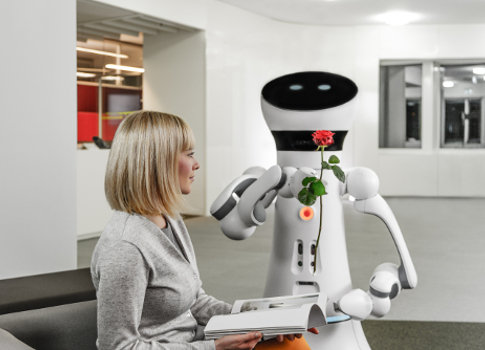The market for service robotics is growing. Service robots have been employed in industrial settings for many years. During the past five years, more than 100,000 service robots for professional use were sold. See comparison to industrial robots.

According to figures provided by the International Federation of Robotics (IFR) around 21,000 service robots were sold for professional applications in 2013, generating sales revenue of $3.6 billion. Since 1998, a total of approximately 150,000 service robots have been used professionally. Some robots (such as underwater robots) might be in operation for more than 10 years, compared to an average of 12 years for industrial robotics. Others, like defense robots, may only serve for a short time.
Until 2008, about 63,500 service robots for professional use were sold during a period of more than 12 years. However, during the past five years, more than 100,000 service robots for professional use were sold. This demonstrates the accelerating rate of increase in sales. Few main application areas make up most of the volume: Service robots used in defense accounted for almost 45% of the total number of service robots for professional use sold in 2013.
Service robot applications
Almost 5,100 milking robots were sold in 2013 compared to 4,750 units in 2012, representing a 6% increase. 760 units of other robots for livestock farming, such as mobile barn cleaners or robotic fencers for automated grazing control, were sold in 2013, resulting in an increase of 46%. The total number of field robots sold in 2013 was about 5,900 units, accounting for a share of 28% of the total unit supply of professional service robots.
Sales of medical robots decreased by 2% compared to 2012 to almost 1,300 units in 2013, accounting for a share of 6% of the total unit sales of professional service robots. The most important applications are robot assisted surgery and therapy. Medical robots are the most valuable service robots with an average unit price of about $1.5 million, including accessories and services. Some suppliers of medical robots provide leasing contracts for robots.
About 1,900 robots for logistic systems were installed in 2013, 37% more than in 2012, accounting for 9% of the total sales of professional service robots. Medical robots as well as logistic systems robots have considerable growth potential.
Industrial and service robots requirements differ
Industrial and service robots differ significantly in terms of specifications. This can be seen when the required positioning accuracy is considered, or how the robots are integrated into the overall system. While traditional industrial robots perform their tasks in clearly structured environments with external safeguards, service robots usually work in unstructured environments and collaborate directly with humans.
While industrial robots are made safe by being deactivated when somebody comes close, service robots have to interact with people. As a result, they require more complex safety concepts in order to ensure safe operation, perhaps even going as far as proximity sensors and tactile skin. Professor Gordon Cheng at the Technical University Munich has been constructing a sensitive skin for robots that will enable close contact between robots and humans. It can also be used in exoskeletons, where the artificial skin gives feedback to the person in the exoskeleton. Researchers found that the brain can adapt to this kind of feedback and help people walk.
Industrial safety standards can be applied to service robotics wherever it makes sense to do so. However, at the same time they must not be overdone and end up running up exorbitant costs. Some smaller aspects, such as gripping technology and kinematics, can be applied to service robotics applications relatively easily. The manufacturer needs to consider the far more varied requirements of service robotics. The line between industrial and service robots has already become blurred in areas such as the automotive industry, for example.
Industrial robots that can built a car or assist a worker in building a car, can also help in everyday situations. Schunk is one of the pioneers in the field of mobile gripping systems. The company’s portable grippers and lightweight arms have been pivotal in the field of service robotics. Dr. Markus Klaiber, Technical Director at Schunk said, “We are also working intensively on seeing grippers. This principle has already been put into practice with the one-finger hand of the Care-O-bot 4, which was developed by the Fraunhofer IPA Institute in Stuttgart in partnership with Schunk.” It can be fitted with a built-in hand camera that allows users to view dimly lit areas on high shelves, for example.
This modular, multi-functional robot assistant is one example for a domestic service robot. Like other service robots, all actuators of the Care-O-bot 4 are controlled via CANopen. Schunk Powerball ERB modules are used as arm joints. They control the movements of two axes in one module with minimum space requirements. The modules also supply high torques and communicate via CANopen.
The Care-O-bot 4 is a mobile robot assistant that is supposed to actively support humans in their daily life. It can be used for a variety of household tasks, for example to deliver food and drinks, to assist with cooking, or for cleaning. The robot can also be applied to a variety of services outside the home: to support patients and personnel in health care institutions, to deliver orders in restaurants, to provide reception and room service in hotels or for entertainment. Unstructured environments are still a problem for the robot, which is why it cannot be used in households yet.
This article is contributed and translated by CAN in Automation (CiA). CiA is a CFE Media content partner. Edited by Joy Chang, digital project manager, CFE Media, [email protected]



